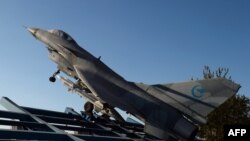The United States has advised American commercial airlines to notify Beijing of flight plans over China's newly-declared air defense identification zone, although U.S. officials say the compliance does not indicate U.S. government acceptance of China's requirements.
The Chinese Defense Ministry declared last week that all aircraft in the zone must identify themselves and obey Chinese orders.
Japan, the United States and South Korea have refused to recognize the Chinese-declared air zone. All three have challenged the zone by sending in military aircraft. The United States, which is obligated by treaty to defend Japan and South Korea, sought to underscore its position by flying two B-52 bombers over the islands this week.
China said Friday it had sent two fighter jets to monitor U.S. and Japanese aircraft that flew into its newly declared air defense zone over the East China Sea.
China's official Xinhua news agency quoted Defense Ministry spokesman Shen Jinke Friday as saying the fighter jets identified two U.S. and 10 Japanese aircraft during their flights over disputed islands controlled by Tokyo and claimed by Beijing.
The report made no mention of any communication or other engagement between the Chinese planes and the U.S. and Japanese aircraft. Washington and Tokyo have not yet commented on the report.
Beijing said Thursday it had sent warplanes into the region on a monitoring mission, but Friday marked the first time officials have reported the monitoring of specific foreign aircraft.
The Chinese response raises the stakes in an international standoff over the the uninhabited islands, known as Senkaku in Japan and Diaoyu in China.
Chinese officials reacted calmly to the U.S. overflights by simply acknowledging them and saying the Chinese military had monitored them without taking action. But that measured response ignited criticism on Chinese micro-blogging sites and in some state media.
The festering dispute with Japan is one of several maritime controversies pitting China against Asian nations, including the Philippines, Vietnam, Brunei and Malaysia.
Beijing has indicated a willingness to negotiate the disputes, but so far has rejected calls for multilateral negotiations. It has sought separate talks with each country.
Some information for this report was provided by AP, AFP and Reuters.
The Chinese Defense Ministry declared last week that all aircraft in the zone must identify themselves and obey Chinese orders.
Japan, the United States and South Korea have refused to recognize the Chinese-declared air zone. All three have challenged the zone by sending in military aircraft. The United States, which is obligated by treaty to defend Japan and South Korea, sought to underscore its position by flying two B-52 bombers over the islands this week.
China said Friday it had sent two fighter jets to monitor U.S. and Japanese aircraft that flew into its newly declared air defense zone over the East China Sea.
China's official Xinhua news agency quoted Defense Ministry spokesman Shen Jinke Friday as saying the fighter jets identified two U.S. and 10 Japanese aircraft during their flights over disputed islands controlled by Tokyo and claimed by Beijing.
The report made no mention of any communication or other engagement between the Chinese planes and the U.S. and Japanese aircraft. Washington and Tokyo have not yet commented on the report.
Beijing said Thursday it had sent warplanes into the region on a monitoring mission, but Friday marked the first time officials have reported the monitoring of specific foreign aircraft.
The Chinese response raises the stakes in an international standoff over the the uninhabited islands, known as Senkaku in Japan and Diaoyu in China.
Chinese officials reacted calmly to the U.S. overflights by simply acknowledging them and saying the Chinese military had monitored them without taking action. But that measured response ignited criticism on Chinese micro-blogging sites and in some state media.
The festering dispute with Japan is one of several maritime controversies pitting China against Asian nations, including the Philippines, Vietnam, Brunei and Malaysia.
Beijing has indicated a willingness to negotiate the disputes, but so far has rejected calls for multilateral negotiations. It has sought separate talks with each country.
Some information for this report was provided by AP, AFP and Reuters.












